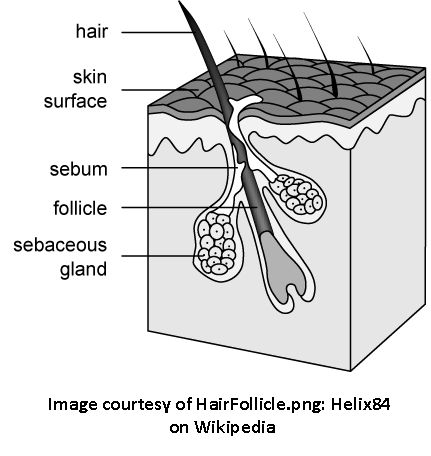Full disclosure: I am not an impartial observer of this disease; I have suffered with it for the last 16 years, so I have great empathy for Jade Pickett Smith.
Alopecia areata is not the same as androgenic alopecia: male- and female- pattern baldness.
Alopecia areata is an autoimmune disease that causes hair loss; it can affect the scalp, eyebrows, eyelashes, and the entire body. It affects men and women equally and occurs in people of all ethnicities, and can occur at any age.
Alopecia areata affects approximately 6.8 million people in the U.S., making it one of the most common autoimmune diseases in this country. There currently is no cure for alopecia areata.
What Causes it?
Alopecia areata is caused by the loss of immune privilege for the hair follicles. What does that mean?
Normally, the body has processes consisting of proteins that activate or turn off genes, making sure the immune system does not attack the hair follicles. With alopecia areata, genes are activated, changing the processes so that the immune system considers the hair follicles a threat, immune privilege is lost, and the immune system attacks the hair follicles.
Why this occurs is not known. However, heredity appears to play a significant role in this disease.
What Do Genes Have to Do with It?
The answer is everything.
If you went to a doctor about 15 years ago or more and got a diagnosis of alopecia areata, most likely, you were told it was caused by stress. This theory is a prime example of “reverse causality.” Because all the patients the doctors saw with alopecia areata exhibited extreme stress, extreme stress must be the cause of the alopecia areata; consider the possibility that the extreme stress resulted from the disease: who wouldn’t be stressed out watching their hair fall out in chunks?
With the completion of the genome project in 2003, the private sector was off and running. They carried out studies looking at the genes of patients with various diseases thought to have some relationship to alopecia areata. Most were dermatological diseases, such as eczema, dermatitis, and psoriasis, but they also included some autoimmune conditions, such as rheumatoid arthritis, type 1 diabetes, and lupus.
There was great surprise in the scientific community when it was found that the genetic risk factors for alopecia areata were not related to skin diseases. Instead, they were related to autoimmune diseases, including:
- Autoimmune thyroid diseases
- Lupus erythematosus
- Type 1 diabetes
- Ulcerative colitis
- Addison’s disease
- Rheumatoid arthritis
I remember my astonishment in 2005 when I stared at the screen at a scientific conference that outlined these results.
It explained it all – my mother had Hashimoto’s thyroiditis (an autoimmune thyroid disease) and rheumatoid arthritis, and my grandfather had Type 1 diabetes. My alopecia areata was not simply bad luck – there was a clear genetic history in my family that predisposed my developing the disease.
A Cure Worse than a Disease?
There is no current FDA-approved treatment for alopecia areata offering long-term results or reversal of hair loss. Most doctors prescribe high-dose corticosteroids, either orally or by injection into the scalp - suppressing the immune system so it no longer can attack the hair follicles. But steroids are nonspecific and suppress general immune system activity, resulting in the body’s inability to fight off other diseases. Additionally, hair regrowth is usually temporary.
The Future
However, all is not gloom and doom in treating alopecia areata. There has been enormous progress in this regard in the last few years. As scientists have discovered the mechanism of action for alopecia areata, they have held clinical trials for several drugs currently approved by the FDA for other uses:
- Ruxolitinib approved for the treatment of poorly formed or functioning blood cells.
- Tofacitinib and Baricitineb both approved for the treatment of rheumatoid arthritis.
These two drugs work by mediating the signals for genes that are responsible for turning off immune privilege in different organ systems. Animal experiments showed great promise, with both medicines preventing the induction of alopecia areata in mice. Early clinical trials (2016) showed promising results, with one study showing hair regrowth in about 67-75% of patients taking the drugs orally.
In March 2021, baricitineb became the first drug to demonstrate efficacy in treating patients with severe alopecia areata. This drug received a “Breakthrough Therapy” designation from the FDA, aimed to expedite the development and treatment of drugs that have been shown to treat a serious condition when there is clinical evidence that the drug shows substantial improvement over currently available therapies. A regulatory decision is expected later this year. Several other drugs show great promise as they undergo clinical trials to treat this disease.
Conclusions
Since 2003 and the completion of the Genomic Project, green shoots of hope have sprung up in many areas of science, demonstrating the power of that breakthrough and underscoring the importance of basic research by the federal government. Alopecia areata is an outstanding example of a reason for genuine hope. In this case, the private sector took genomics and brought it to life quickly. This would not have happened without a new coalition of a diverse group of policy associations representing specialized diseases that came together with one purpose – to develop a cure for each disease. By coordinating their efforts, they were able to see that a drug currently FDA-approved for one condition, rheumatoid arthritis, could be the cure for another, alopecia areata.
Alopecia areata is a disease that can be a punch line for a joke, but if you are a child, a young person, or even a fully grown adult, you are hoping that the FDA moves with real speed and brings solutions to the market - hopefully it will not take another 10 years for this to happen!





